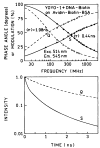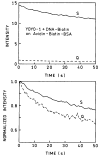Increased intensities of YOYO-1-labeled DNA oligomers near silver particles
- PMID: 12870845
- PMCID: PMC2753835
- DOI: 10.1562/0031-8655(2003)077<0604:iioydo>2.0.co;2
Increased intensities of YOYO-1-labeled DNA oligomers near silver particles
Abstract
DNA detection is usually performed using fluorescence probes. Using a DNA oligomer stained with the widely used dye 1,1'-[1,3-propanediylbis[(dimethylimino)-3,1-propanediyl]]bis[4-[(3-methyl-2(3H)-benzoxazolylidene)methyl]]-quinolinum tetraiodide (YOYO-1), we show that a substrate containing silver particles can lead to a greater than 10-fold increase in the fluorescence intensity. Proximity to silver particles also increases the photostability of YOYO-1-DNA. These results suggest that substrates or gels containing silver particles may be used for increased sensitivity in DNA detection.
Figures






Similar articles
-
Fluorescence images of DNA-bound YOYO between coupled silver particles.Langmuir. 2007 Nov 6;23(23):11734-9. doi: 10.1021/la702064v. Epub 2007 Oct 3. Langmuir. 2007. PMID: 17914851 Free PMC article.
-
Stable fluorescent complexes of double-stranded DNA with bis-intercalating asymmetric cyanine dyes: properties and applications.Nucleic Acids Res. 1992 Jun 11;20(11):2803-12. doi: 10.1093/nar/20.11.2803. Nucleic Acids Res. 1992. PMID: 1614866 Free PMC article.
-
1H NMR studies of the bis-intercalation of a homodimeric oxazole yellow dye in DNA oligonucleotides.J Biomol Struct Dyn. 1998 Oct;16(2):205-22. doi: 10.1080/07391102.1998.10508240. J Biomol Struct Dyn. 1998. PMID: 9833661
-
Triplet fraction buildup effect of the DNA-YOYO complex studied with fluorescence correlation spectroscopy.Anal Biochem. 2007 Jul 1;366(1):87-92. doi: 10.1016/j.ab.2007.03.040. Epub 2007 Apr 24. Anal Biochem. 2007. PMID: 17490596
-
Structure and dynamics of condensed DNA probed by 1,1'-(4,4,8,8-tetramethyl-4,8-diazaundecamethylene)bis[4-[[3- methylbenz-1,3-oxazol-2-yl]methylidine]-1,4-dihydroquinolinium] tetraiodide fluorescence.Biochemistry. 2002 Dec 24;41(51):15277-87. doi: 10.1021/bi020440y. Biochemistry. 2002. PMID: 12484766
Cited by
-
Advances in surface-enhanced fluorescence.J Fluoresc. 2004 Jul;14(4):425-41. doi: 10.1023/b:jofl.0000031824.48401.5c. J Fluoresc. 2004. PMID: 15617385 Free PMC article. Review.
-
Fluorescence spectral properties of labeled thiolated oligonucleotides bound to silver particles.Biopolymers. 2004 Jun 15;74(3):263-71. doi: 10.1002/bip.20071. Biopolymers. 2004. PMID: 15150802 Free PMC article.
-
Increasing the sensitivity of DNA microarrays by metal-enhanced fluorescence using surface-bound silver nanoparticles.Nucleic Acids Res. 2007;35(2):e13. doi: 10.1093/nar/gkl1054. Epub 2006 Dec 14. Nucleic Acids Res. 2007. PMID: 17169999 Free PMC article.
-
Dansyl-Labelled Ag@SiO2 Core-Shell Nanostructures-Synthesis, Characterization, and Metal-Enhanced Fluorescence.Materials (Basel). 2020 Nov 16;13(22):5168. doi: 10.3390/ma13225168. Materials (Basel). 2020. PMID: 33207805 Free PMC article.
-
Strategy for photostable proximity bioassays using lanthanides.Appl Opt. 2007 Apr 1;46(10):1918-23. doi: 10.1364/ao.46.001918. Appl Opt. 2007. PMID: 17356638 Free PMC article.
References
-
- Benson SC, Zeng Z, Glazer AN. Fluorescence energy transfer cyanine heterodimers with high affinity for double-stranded DNA. Anal Biochem. 1995;231:247–255. - PubMed
Publication types
MeSH terms
Substances
Grants and funding
LinkOut - more resources
Full Text Sources
Other Literature Sources
Miscellaneous

